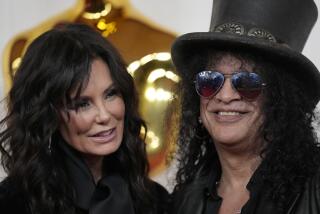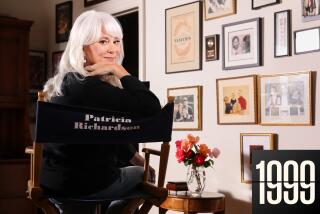Big lessons for a little ballerina
MY mother -- bulging with the bump that would soon be my baby sister -- decided I was in need of a worthwhile activity of my own. Conscientious Jewish parent that she was, she didn’t make her choice lightly. Together, we set out to find a dancing school that would offer just the right mix of healthy exercise, high culture and progressive social values.
It was 1950, and I was not quite 4 years old.
Our first stop was a conventional dance studio, all big mirrors and big windows. I remember little girls in ballet slippers and stiff pink tutus prancing to the tune of a tinkling rehearsal piano. It looked fine to me. But my mother, proud of being a forward thinker, wasn’t satisfied.
Then we moved on to 7566 Melrose Ave., and I fell in love.
Today, it’s a store selling adult videos and sex toys. But back in the ‘50s, long before Melrose became a destination for funky shopaholics, the building was home to the Lester Horton Dance Theater. Horton, a largely self-taught dancer fascinated by Native American lore, moved from Indianapolis to Southern California in 1929. From the first, he dreamed big. In 1948 he joined with dancer Bella Lewitzky and her husband, Newell Reynolds, to create America’s first permanent venue devoted to modern dance.
The technique Horton taught his young troupe is still revered among dancers. But his choreographic masterpieces -- which include his brutal revenge duet “The Beloved,” his boldly erotic “Salome” and his airy and whimsical “Another Touch of Klee,” set to a Stan Kenton score -- have largely vanished. Though Horton’s annual seasons attracted many L.A. artists and intellectuals, the fact that he lived his life far from Manhattan meant his work lacked a stamp of approval from New York’s arbiters of culture. A 1993 documentary by one of my own teachers, former Horton dancer Lelia Goldoni, takes its title from the phrase with which Clive Barnes paid posthumous tribute to Horton in the New York Times: “Genius on the Wrong Coast.”
But for me and my classmates, Horton’s reputation in the mainstream dance world was irrelevant.
In an era that regarded nonconformity with suspicion, Dance Theater stood out as bravely, beautifully different. There were no big mirrors, no ballet bar, just a large empty stage. Dancers performed barefoot, undulating to the rhythms of an exotic collection of drums. We called the beat “Afro-Cuban,” but our movements drew inspiration from near and far: Mexico, Bali, Brazil.
Then there were the dancers themselves. The adults in the performing company -- who also taught classes, made costumes and served as role models for awestruck youngsters -- came in a rainbow of colors. Horton himself was a white man from the heart of the heartland. Others derived from ethnic stock: Italian American, Japanese American. But many of the dancers who shaped my life were what my West L.A. neighbors might have called “colored.”
For me, of course, it hardly mattered. I was aware of racial differences only when I went to draw pictures of my heroes for my scrapbook. My Crayola box gave me far too few choices, and “flesh” didn’t convey the range of skin tones I saw all around me. (I used it anyway.)
Some of those colorful dancers went on to be famous. Though Horton died far too young, carried off by a heart attack at age 47 in 1953, many of his proteges soon made their mark as performers, choreographers and teachers. Horton star Carmen de Lavallade, idol of every small girl at Dance Theater, moved to New York, where she became only the third black ballerina hired by the Metropolitan Opera. (Today, at seventysomething, she’s still dancing, still teaching, still beautiful.)
Alvin Ailey, whose intense gaze and glistening brown torso had me mesmerized, went east too. It was not long before his Alvin Ailey American Dance Theater, combining Horton-style multiculturalism with a nod to his own African American heritage, was hailed as a vibrant addition to the international dance scene.
No one stays colorblind forever. Before I left Dance Theater at age 10, I had a clearer sense that the school was an island surrounded by rough seas. From my parents, I learned that the performing troupe regularly lost jobs on movie sets and nightclub stages because Horton refused to segregate his dancers into all-black and all-white squads. I also overheard the horrified whispers when one of the male dancers, newly drafted into the military, was wrongly accused of rape because his skin color made him a convenient target.
Around the same time, my parents drove to Las Vegas to see De Lavallade and two male dancers open for singer Pearl Bailey. At the Flamingo Hotel, then one of the Strip’s finest, Carmen’s name blazed forth on the marquee, and she danced nightly in an opulent showroom for appreciative crowds. But she was not allowed to lodge at the Flamingo. Her cafe au lait coloring meant she was stuck all day in a stuffy motel room, without access to the swimming pool and other amenities that made the Flamingo a world-class resort. So my parents gave up fun in the sun to spend their weekend keeping her company. When they got home, they told me all about it. It made no sense to me then ... and it still doesn’t. But I learned once more that the world outside of Dance Theater was not always a graceful place.
It’s been a long time since I considered myself a junior Horton dancer. Yet I have not forgotten. Nor has the Dance Resource Center of Los Angeles. Though I’ll never win a Horton plaque, I feel I’ve been rewarded in other ways. Back in the monochrome ‘50s, a Technicolor troupe of dancers showed me that beauty comes in many hues.
*
Gray has worked as a screenwriter and story editor; among her books is “Roger Corman: Blood-Sucking Vampires, Flesh-Eating Cockroaches, and Driller Killers.”
*
Lester Horton Dance Awards
Where: Alex Theatre, 216 N. Brand Blvd., Glendale
When: 5 p.m. today
Price: $25 and $45
Contact: (818) 243-2539
More to Read
The biggest entertainment stories
Get our big stories about Hollywood, film, television, music, arts, culture and more right in your inbox as soon as they publish.
You may occasionally receive promotional content from the Los Angeles Times.






